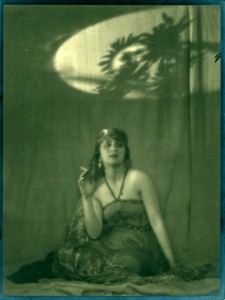
Arthur Kales: “Ruth St. Denis,” c. 1910
Gift of C. Jane Hurley Wilson ’64 and Michael G. Wilson
2008.4.21
This photograph is a portrait of Ruth St. Denis (1879-1968) taken by Arthur Kales (1882-1936), a prolific American pictorialist photographer during the 1920s. Pictorialist photographers believed that photographs should emulate the formal elements of etchings or paintings. Pictorialists renounced the sharp accuracy of a photographic image, thus the film was subdued by soft focus and other photographic techniques. The photographers often planned the picture’s scenarios, much like a painter composes a painting. Arthur Kales joined this movement while he was in his late 20s. Born in Arizona in 1882, Arthur Kales moved to California in 1903 where he remained for the rest of his life. Initially pursuing a law degree, Kales found photography instead. By 1918, Kales was deeply committed to the popular Los Angeles pictorialist movement. By 1922 he was a regular essayist for the journal, Photogram of the Year. In 1928, Kales was awarded a fellowship from the United Kingdom’s Royal Photographic Society and was given a fifty-print retrospective by the Smithsonian Institution in Washington D.C. Despite his vast repertoire of subject, matter, his work can be identified by his ethereal yet exquisitely intricate compositions.
Arthur Kales’ portrait of Ruth St Denis gives dimension to a compelling artistic discourse about cultural diversity in America. This photograph was taken in 1910 just after St. Denis had finished a three-year United Kingdom dance tour of Translations, a series of decorative solo dances inspired by ethnic traditions ranging from the Middle East to Japan. Ruth St. Denis reclines in an exotic costume while smoking a cigarette. The shadow design in the background completes the intended suggestion of a faraway land, and in this image Ruth St. Denis becomes the quintessential embodiment of America’s turn-of-the-century infatuation with exotica.
Ruth St. Denis is known as a fundamental innovator of modern dance in America, and is cited among other major dance figures, such as Isadora Duncan (1877-1927) and Loie Fuller (1862-1928). She co-founded the influential Los Angeles dance school, Denishawn, in 1915. Dissatisfied with traditional ballet, St. Denis integrated eastern forms of movement and costume into her dance theory. Her choreography was performed in vaudeville and elite theatres alike. She sought a dance that did not merely entertain, but rather maintained a deeper spiritual and philosophical expression that was often linked to non-western traditions.
Kales’ ethereal, sepia-toned representation not only supports St. Denis’ ‘exotic’ identity but also exemplifies fundamental aspects of pictorialist photography. Any personal artistic expression could be seen in the manipulation of photographed image. Thus, there was a heavy emphasis on image-altering methods, such as soft focus, special filters and lens coatings and new darkroom processes.
Thus, this picture attests to the most fashionable social and aesthetic practices of this time period. Kales’ portrait captures the fabricated foreignness of St. Denis’ persona and dance theory while asserting the formal tenets of pictorialism.
Written by Kayla Erickson (SC ’10), 2008-2009 Academic Year Wilson Intern

